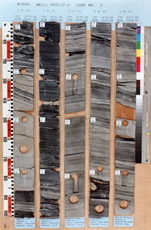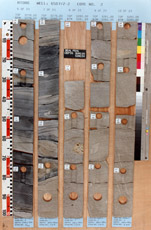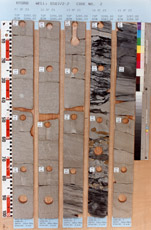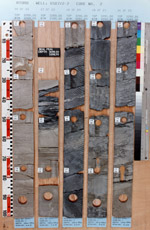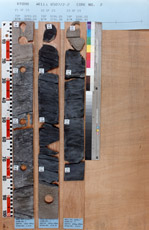Breiflabb Member [new]
updated to follow: Stratigraphic Guide to the Cromer Knoll, Shetland and Chalk Groups of the North Sea and Norwegian Sea. Felix M. Gradstein & Colin C. Waters (editors), Mike Charnock, Dirk Munsterman, Michelle Hollerbach, Harald Brunstad, Øyvind Hammer & Luis Vergara (contributors). Newsletter on Stratigraphy, vol 49/1 pp71-280, 2016
Shetland Group,
Blålange Formation, Norwegian Sea
Introduction
The Breiflabb Member (new) is part of the
Blålange Formation. The new member comprises an interval of interbedded sandstones and mudstones of Late Cretaceous, early Turonian age found along the Halten and Dønna Terraces.
The stratigraphic relationship with the overlying Lysing Member may be seen in the well 6507/7-1 (reference well), where over 450m of Turonian mudstone separates the two sand-prone units.
Name
English/ Norwegian and any previous names: The Breiflabb Member is informally recorded on the completion logs of the type well 6507/2-2 by the operator as the 'lower Lange Sandstone II'. The underlying Smørflyndre Member (new) was informally assigned 'lower Lange Sandstone I' by the same operator. Confusingly, in other wells the unit is described as 'intra Lange Sandstone' I to V depending on various operators naming conventions in ascending or descending order. In the reference well 6507/7-1 the unit is described by the operator as the 'Upper Cretaceous Sandstone II'; the Lysing Member being originally described as 'Upper Cretaceous Sandstone I' and separated by over 450m of 'Upper Cretaceous shales'.
Derivatio nominis:
The name Breiflabb is the Norwegian name for the angler fish Lophius piscatorius, a
bottom dwelling fish living from the littoral zone down to 600 m depth or more along the
Norwegian coast and fjords.
Lithology
The Breiflabb Member consists of interbedded sandstones and mudstones.The sandstones are white, light grey, yellow grey to grey brown, clear to frosted quartz grains, very fine to medium, occasionally coarse, occasionally fine, occasionally very coarse to conglomerate, moderate to poorly sorted, angular to sub-rounded, friable to moderately hard, locally calcareous, dolomitic and siliceous cemented, occasional argillaceous matrix, very micaceous with traces of pyrite and glauconite, poor visible porosity. In the type core 6507/2-2 clasts of mudstones, sandstones and conglomerate, e.g. 3280.5mMD are present. Sandstone bed thickness varies from a few centimetres to 5.5m.
The mudstones are medium dark grey to olive black, soft to firm, predominantly non-calcareous, dolomitic in part, micro-micaceous, silty and locally carbonaceous with trace glauconite.
Thickness
The Breiflabb Member varies in thickness from 3 m to 89.5 mMD e.g. 6506/11-7 with an average 35 mMD. Its thickest development is in block 6506/11 (Smørbukk area).
Geographical distribution
The Breiflabb Member is developed in Quadrants 6406 (blocks 1, 2 and 6), 6407 (block 7),
6506 (blocks 11 and 12) and 6507 (blocks 2, 5 and 7) along the western margin of the
Halten and Dønna Terraces where it is locally sourced from up-dip locations on the
Trøndelags Platform and from local highs.
Core photographs
Type well 6507/2-2:
core#2 3295.8 mMD - 3273 mMD RKB. Core photographs are available and show the well defined
lower boundary at 3295.15 mMD (3298 m corrected core depth) at the base of a 30 cm thick
sandstone bed.
Reference well 6507/7-1:
no cores were taken in well.
Type well
Well name: 6507/2-2
WGS84 coordinates: N 65°55'01.69", E 07°30'54.56"
UTM coordinates: 7311658.70 N 432390.90 E
UTM zone: 32
Drilling operator name: Norsk Hydro Produksjon AS
Completion date: 16.03.1992
Status: P & A
Interval of type section (m) & thickness in type well:
3293 m - 3263 m, 30m thickness.
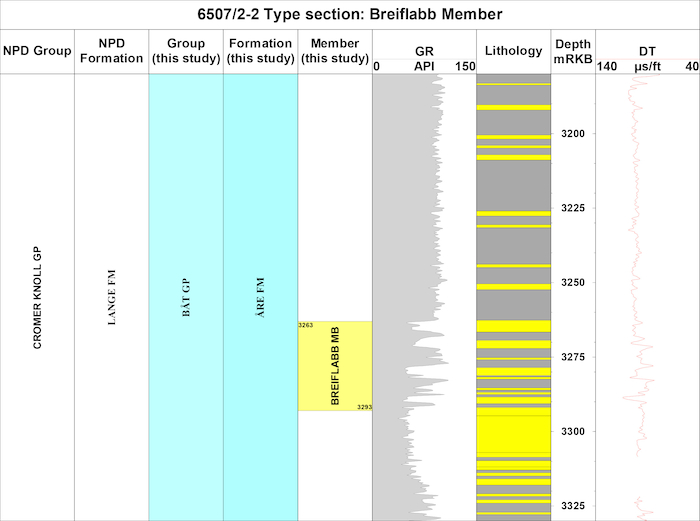
Logs of the type well 6507/2-2 (click to enlarge)
Reference well
Well name: 6507/7-1
WGS84 coordinates: N 65°27'16.7", E 07°12'52.6"
UTM coordinates: 726081.16 N 417247.40 E
UTM zone: 32
Drilling operator name: Conoco Norway
Completion date: 01.12.1984
Status: P & A
Interval of reference section (m) & thickness in reference well:
3523 m - 3495.5 m, 27.5m thickness.
Upper and lower boundaries
Lower boundary
In the type well 6507/2-2 the base of the Breiflabb Member is well defined in core at
3295.15 m MD at the base of a 30 cm thick sandstone bed and represents a sharp boundary
between sandstones and dark mudstones of the underlying (and laterally adjacent)
Blålange Formation.
This is represented by a sharp and well defined decrease on the gamma ray logs
at 3292.7 m (implying a -2.5 mMD discrepancy between core and logs). The change in bulk
density logs is slightly higher at 3292.25 m level and above this the log shows a
distinctive irregular response. The Breiflabb Member has a similar log response in the
reference well 6507/7-1.
Upper boundary
The upper boundary is well defined on wireline logs. It can be seen in the type well 6507/2-2 to be defined on an abrupt increase in gamma ray values and decrease in resistivity logs interpreted as representing the sudden cessation of sandstone deposition. The sonic log response is less significant but still quite marked and shows an up-section change from irregular to more constant values. There is also an associated pronounced up-section positive separation on neutron porosity and density logs in response to the rapid termination of sandstones and the deposition of uniform and monotonous sequence of mudstones of the overlying, and encapsulating Blålange
Formation.
Well log characteristics
The log response of the Breiflabb Member is typically characterised by a very irregular to
serrate log profile on gamma-ray, bulk density and sonic velocity logs reflecting the
interbedded nature of the sandstones and mudstones.
Type seismic section
NH90-10-102
Biostratigraphy
The main stratigraphic control of the Blålange Formation and the Breiflabb Member, in
particular, are dinoflagellate cysts. Planktonic foraminifera are scarce or are locally
common at only discrete horizons and are represented by small smooth hedbergellid species,
most notably H. delrioensis that are typical of a Turonian or older age.
Below the Breiflabb Member is the FO Heterosphaeridium difficile (in sidewall cores in the
type well
6507/2-2) providing an age no older than early Turonian . Further support for an
early Turonian age is the FO Chatangiella dittissima in the lower part of the
member. In
the reference well 6507/7-1, the Breiflabb Member is developed above the Cenomanian dinocyst markers
LO Gonyaulacysta cassidata, LO Rhombodella paucispina and LO
Epelidosphaeridia spinosa and
within the range of rare Litosphaeridium siphoniphorum (early Turonian).
Dating of the upper boundary of the Breiflabb Member is more difficult to establish but
appears to be close to the early/middle Turonian boundary based on the influx of
Surculosphaeridium longifuratum in the upper part of the member in cores. The LCO
Cyclonephelium membraniphorum within the middle part of the Breiflabb Member is a
typical
early Turonian dinocyst event. The microfaunal associations are dominated by agglutinated
foraminifera but these provide important information on the environment of the deposition
rather than the age (see below). An influx of siliceous radiolarian above the member is a
useful correlative event and is probably related to a change in water mass conditions
associated with a rise in relative sea level that can be linked to the cessation of sand.
In summary, the Breiflabb Member is mainly early Turonian age or may extend into the
'earliest' middle Turonian.
Reworking of Cenomanian dinocysts complicates the dating but when properly distinguished
(within the range of the Turonian restricted H. difficile) provide an indication of
the sediment source, presumably derived by local syn-sedimentary erosion from up-dip slope
locations or from the Trøndelags Platform.
Age
Late Cretaceous, early Turonian - 'earliest' middle Turonian.
Correlation
The interbedded sandstones and mudstones of the Breiflabb Member pass laterally into
mudstones of the Blålange Formation.
The stratigraphic relationship with the overlying
Lysing Member can
be seen in the well 6507/7-1 (type well) where over 450 m of Turonian mudstones separate
the two sand-prone units.
The Breiflabb Member is part of the K60 sequence of Vergara et al. (2001), K50
sequence of
Færseth and Lien (2002) and Lien (2005) and K66- K67 sequences of Fugelli and Olsen (2005a
figure 2).
Depositional environment
Based on the operator's descriptions of cores from the type well 6507/2-2, the sandstones of the Breiflabb Member are considered to have been deposited as mostly submarine fan lobe deposits on a slope or basin floor setting.
Three sedimentary facies were distinguished by the operator:
1) a lower interbedded unit (3295.98 m base - 3286 m) of high density turbidites and debris flows and bioturbated hemipelagic mudstones deposited on a slope or basin floor setting,
2) a middle unit (3286 m - 3279 m) representing a single amalgamated turbidite interpreted as a fan lobe and
3) an upper unit (3279 m - 3273 m) of more interbedded low density turbidites and hemipelagic mudstones deposited on a distal submarine fan.
Study of the biofacies shows that rare lituolid-agglutinated foraminifera are present in the cores e.g. 3479.2 mMD, and these suggest a relatively deep marine setting with dysoxic bottom conditions. Some of the thicker dark mudstones are devoid of benthic microfauna and may suggest a temporarily anoxic sea floor, or highly depleted oxygen levels within the uppermost few centimetres of sediment.
Remarks
Sandstones of the Breiflabb Member have had less attention compared to those of the overlying Lysing sand complex where the facies architecture has been studied at a variety of different scales and compared with outcrop analogues (see Olsen 2005 a, b). Vergara et al. (2001) however, described a possible middle Cenomanian tectonic event and relative sea level fall that may coincide with the deposition of the Breiflabb Member, and that this event caused extensive emergence and erosion along the Halten Terrace and western Trøndelags Platform. It is suggested (this study) that this event is not a single event but a more complex development with a series of step-wise unconfomities at base Cenomanian, middle Cenomanian and early Turonian levels as determined by the progressive onlap of the Turonian mudstones of the Blålange Formation onto
progressively older
Cenomanian e.g. type well 6507/2-2 or Lower Cretaceous, Albian sediments of the
Lange
Formation. It is therefore likely that the deposition of the Breiflabb Member is
related to this event and the result of erosion of up-dip areas either during the lowered base
level or subsequent early transgressive phase.
References
Færseth, R. and Lien, T. 2002. Cretaceous evolution in the Norwegian Sea - a period
characterized by tectonic quiescence.
Marine and Petroleum Geology 19:1005-1027.
Fugelli, E. and Olsen T. R. 2005a. Screening for deep-marine reservoirs in frontier basins:
Part 1 - Examples from offshore mid- Norway.
AAPG Bulletin 89(7):853-882.
Lien, T. 2005. From rifting to drifting: effects on the development of deep-water hydrocarbon
reservoirs in a passive margin setting, Norwegian Sea.
Norwegian Journal of Geology 85:319-332.
Vergara, L., Wreglesworth, I., Trayfoot, M., Richardsen, G. 2001. The distribution of Cretaceous
and Paleocene deep-water reservoirs in the Norwegian Sea basins.
Petroleum Geoscience 7:395-408.


